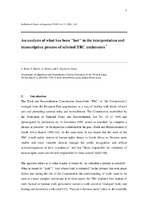| dc.contributor.author | Bock, Zannie | |
| dc.contributor.author | Mazwi, Ngwanya | |
| dc.contributor.author | Metula, Sifundo | |
| dc.contributor.author | Mpolweni-Zantsi, Nosisi | |
| dc.date.accessioned | 2011-03-07T14:41:40Z | |
| dc.date.available | 2011-03-07T14:41:40Z | |
| dc.date.issued | 2006 | |
| dc.identifier.citation | Bock, Z., et al. (2006) An analysis of what has been “lost” in the interpretation and transcription process of selected TRC testimonies. Spil PLUS, 33: 1-26 | en_US |
| dc.identifier.uri | http://hdl.handle.net/10566/214 | |
| dc.description.abstract | The main aim of this research is to evaluate “what has been lost” in the simultaneous interpretation and transcription processes of selected Truth and Reconciliation Commission (TRC) testimonies. The testimonies under consideration are those of two of the widows of the Cradock Four who were murdered by the South African Security Branch in 1985 for their work in mobilising resistance to apartheid. The widows testified in Xhosa at the East London Human Rights Violation hearings in 1996 and their testimonies were simultaneously interpreted into English on the day of the hearing. Using audiovisual copies of the testimonies on which one can hear the original soundtrack, as well as the English voice-over, we transcribed the testimonies in the source language (e.g. Xhosa). We then translated these into English and compared our translation with the official English versions which are published on the TRC website. Our analysis revealed that a significant number of meanings were lost under the pressures of simultaneous interpretation. These meanings related predominantly to the ‘emotional’ content: for example, to aspects of narrative style expressed through gesture, intonation, repetition and the use of direct speech, particularly the verbatim quotes of the police in Afrikaans. We also noted that an understanding of the culture of the testifier was essential to understanding the testimony and that researchers who did not have access to the testimony in the source language and the cultural codes of the testifier would be significantly compromised when trying to understand the testimonies. In addition, we noted the loss of a number of factual meanings as a result of inaccuracies and omissions both during the interpretation and transcription process. We argued that these losses and omissions detracted primarily from what the TRC referred to as the ‘narrative truth’ or subjective meanings of the testimonies, and, in some cases, the ‘factual truth’. We undertook this research because we are concerned that many researchers only have access to the official TRC record. This record, in our view, is in some cases compromised as the processes of simultaneous interpretation and transcription inevitably led to some loss of meaning due to the pressures and constraints under which the interpreters were working. | en_US |
| dc.language.iso | en | en_US |
| dc.publisher | Department of General Linguistics, Stellenbosch University | en_US |
| dc.rights | Copyright Zannie Bock and co-authors. This file may be freely used for educational purposes, as long as it is not altered in any way. Acknowledgement of the author and publication is required. | |
| dc.source.uri | http://dx.doi.org/10.5842/33-0-22 | |
| dc.subject | Truth and Reconciliation Commission (TRC) | en_US |
| dc.subject | Human rights violations | en_US |
| dc.subject | Testimonies | en_US |
| dc.subject | Cradock Four | en_US |
| dc.subject | Simultaneous interpretation | en_US |
| dc.subject | Transcription | en_US |
| dc.subject | Narrative truth | en_US |
| dc.title | An analysis of what has been "lost" in the interpretation and transcription process of selected TRC testimonies | en_US |
| dc.type | Article | en_US |
| dc.inquiries | zbock@uwc.ac.za | |
| dc.privacy.showsubmitter | true | |
| dc.status.ispeerreviewed | true | |

